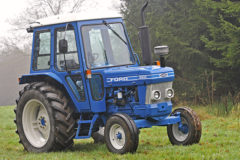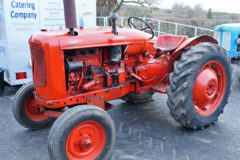Top 10 tractors from the 1970s
Posted by Chris Graham on 16th January 2020

Here are our Top 10 tractors from the 1970s; an interesting and exciting decade for tractor production. Which is your favourite?
Considering the two decades that had gone before, and the growth and prosperity that Britain had enjoyed compared to the austerity of the war years, the 1970s came as a bit of a shock to the system. Britain ended up in the midst of trade union strikes, there was the 1973 oil crisis, fuel price rises and severe inflation to boot. Plus, trade with the Commonwealth had fallen (although the level of trade with the European Economic Community (EEC) had nearly doubled) – which prompted the UK to become a member of the EEC in 1973. This appeared to be good for the economy as a whole, as well as for British agriculture, as the EEC’s Common Agricultural Policy (CAP) suggested that farmers would be encouraged to maximise outputs.
For the tractor manufacturers, with Britain still very much a beating heart in terms of its output, the 1970s was an eclectic mix of revised existing ranges and exciting, new technology. One of the most obvious differences to tractors was the introduction of the safety cab, whereby all new tractors sold in the UK were required, by law, to have an approved rollover structure fitted from 1 September 1970.
Cab design was taken a stage further in the middle of the decade, when it became a requirement for all new tractors sold after 1 June 1976 to have interior noise levels no greater than 90dB(A). These new ‘Q’ (quiet) cabs changed tractor design and the lives of operators forever, not only in terms of noise levels, but in how tractor manufacturers began to address the issue of operator comfort in general.
In terms of mechanical advances, three of the major milestones were the introduction of new transmission technology, turbocharging and ‘mainstream’ four-wheel drive. International Harvester was the first to throw its hat in the ring in terms of gearbox technology, when it introduced the World Wide Series in 1970. The new 454 and 574 featured either a synchro transmission with hip-level controls, heralded by critical acclaim, or a hydrostatic unit for unparalleled control.
Although not new, hydraulically-controlled transmissions were not a frequent sight on tractors working in Britain, but David Brown set about changing that when it introduced Hydra-Shift in 1971 – a ‘semi-automatic’ transmission that subsequently received the Queen’s Award for technological achievement.
Ford, not to be outdone in terms of the attention it received, launched the 7000 around the same time. Essentially a turbocharged 5000, the new tractor paved the way for such technology and it was soon customary to find a four-cylinder tractor equipped with either a factory-fitted turbocharger or a system offered by one of the aftermarket suppliers that quickly became commonplace – such as Opico and TB.
Massey Ferguson, still revelling in the success of the 100 Series, did not start production of its new range until 1976. The 500 Series was designed with its predecessor as the backbone, but new styling, a new cab and further refinements made for a great replacement.
The final major player in the UK tractor industry, Leyland, saved all of its developments until the end of the decade. The two-wheel drive Synchro models were launched in March 1978 and these were followed by the four-wheel drive 462 and 472 in the summer of the same year, while the six-cylinder 285 and 2100 received the Synchro transmission in 1979. Two new turbocharged models, the 282 and 482, were first seen at the Smithfield Show at the end of that year.
On the following pages are the tractors that have made our Top 10 of the 1970s. If you agree or disagree, please get in touch (tm.ed@kelsey.co.uk) or comment on our Facebook page (www.facebook.com/TractorAndMachinery).
Massey Ferguson 135

(Pic: Andy Holmes)
There are few tractors, from any decade, that can match the popularity of the Massey Ferguson 135. Its production run, spanning one-and-a-half decades says it all! Although it was introduced in the mid-1960s and saw the decade out as one of the UK’s best-loved models, the 1970s was arguably the tractor’s best period – with more than half of the 135s build tally chalked up in the disco decade.
The Ferguson System hydraulics and AD3.152 engine, built by Perkins, made for a phenomenal, compact package. The engine remains one of the best ever to power an agricultural machine, as it started well, was frugal, had torque in abundance and was uprated during the ’70s from 45.5hp to 47hp to make it even better!
Other improvements for the 1970s included the straight, ‘heavy-duty’ front axle and the safety cab – available with either flexible cladding or rigid – to meet the new legislation. MF’s change-on-the-move Multi-Power transmission became more popular too, although the standard six forward, two reverse system was still attractive for those looking to curb costs.
At a glance
- Bulletproof engine built by Perkins to MF specifications
- Draft control to rival any tractor on the market
- The sub-50hp tractor of the decade
Built: 1964-79
Engine: Perkins, 2,502cc
Cylinders: 3
Power: 47hp
Transmission: 6 fwd, 2 rev
Weight: 1,788kg
Tyres: 6.00-16, 11-28
Note: Standard spec.
Ford 4000
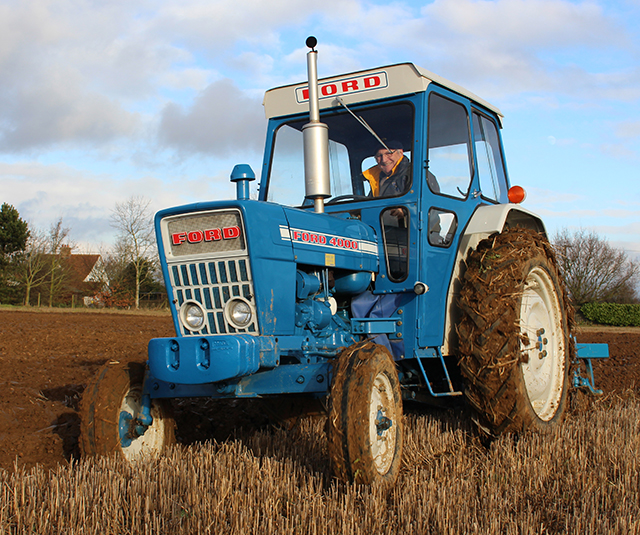
(Pic: Jonathan Whitlam)
Rather like the Massey Ferguson 135, the Ford Force 4000 saw out the 1960s as one of Britain’s most popular tractors and built on its success during the new decade.
With the teething troubles of the 6X (pre-Force) range behind it, the ‘new’ 4000 took the concept of the ‘square’ engine design to new heights, continuing to enjoy immense popularity despite the fact that it was up against two other 62hp heavyweights – the omni-present Massey Ferguson 165 and ground-breaking International 574.
The constant-mesh transmission proved to be the most commonly specified, although the 10-speed Select-O-Speed option was available as an alternative for those looking for something different. An independent power take-off was part of the standard specification and a comprehensive list of alternative equipment, including power-assisted steering and pick-up hitch, transformed the 4000’s characteristics.
Ford met the required standard for safety cab legislation with the introduction of a rigid-clad unit built by Fieco in Denmark, complete with sliding side windows as standard and the option of a deluxe version featuring a steel-framed rear window.
At a glance
- Well-liked engine with identical bore and stroke dimensions
- Single-lever hydraulic control
- A viable alternative to the four-cylinder opposition
Built: 1968-75
Engine: Ford, 3,294cc
Cylinders: 3
Power: 62bhp
Transmission: 8 fwd, 2 rev
Weight: 1,788kg
Tyres: 6.00-16, 11-36
Note: Standard spec.
International 454

(Pic: Scott Lambert)
The first ‘new’ tractor in our Top 10 was introduced alongside the four-cylinder 574 at the Smithfield Show in 1970. IH claimed that they were the “kind of tractors you’d design for yourself” and had a host of features that set them apart from their rivals.
The German-built, D-179 three-cylinder engine was initially rated at 48hp, although this was later uprated to 52hp. It was renowned for its torque and was a good match for the new synchromesh transmission, controlled by levers to the left of the driver, at hip level.
Although the floor wasn’t flat, the fact that the gear levers were positioned next to the seat meant that access was easy and the driver could enjoy a smoother ride, thanks to the platform being forward of the rear axle.
Available with either a basic safety frame or rigid-clad cab based on the same structure, built by Victor, the 454 set new standards for tractor design – with hydrostatic power steering, synchromesh transmission, wet disc brakes and integral safety cab as standard.
At a glance
- Introduced to critical acclaim, due to ground-breaking design
- Clutter-free operator area with hip-level controls
- Option of hydrostatic transmission (from Spring ’71)
Built: 1970-77
Engine: IH, 2,934cc
Cylinders: 3
Power: 48hp, 52hp
Transmission: 8 fwd, 4 rev
Weight: 2,089kg
Tyres: 5.50-16, 12.4/11-32
Note: Standard spec.
David Brown 1212
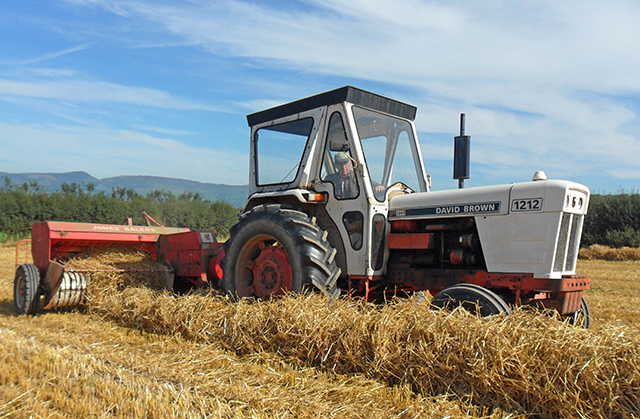
(Pic: Emyr Hughes)
Both the David Brown 1210 and 1212 featured a 12 forward, four reverse transmission, but the fundamental difference was the way in which it operated. The 1210 was a traditional manual unit, with synchromesh from first to second and third and back to second, while the 1212 incorporated DB’s innovative Hydra-Shift ‘semi-automatic’ system with clutch-less, on-the-move changes in any of the three forward ranges or single reverse range.
Hydra-Shift received the Queen’s Award to Industry for technical achievement in 1974 and the Design Council Award in 1976, changing the way that operators thought about tractor transmissions forever and setting the 1212 apart from other tractors in the same power bracket.
The Weatherframe cab was disappointing, in that it was extremely tall and difficult to get in and out of, but the AD4/55 direct-injection engine, hydrostatic power steering and Selectamatic hydraulic system more than made up for it.
Unfortunately, four-wheel drive was not an option for the 1212 as it was on the 1210, because Hydra-Shift tractors could not be specified with a driven front axle until much later.
At a glance
- Innovative, versatile transmission that changed perceptions
- Well-built engine with plenty of power and torque
- Proven Selectamatic hydraulic system
Built: 1971-80
Engine: David Brown, 3,594cc
Cylinders: 4
Power: 72hp (DIN)
Transmission: 12 fwd, 4 rev
Weight: 3,050kg
Tyres: 7.50-16, 13.6/12-38
Note: Standard spec.
Ford 7000

(Pic: Bob Weir)
.If Ford’s 4000 enhanced the original 6X concept, the 7000 certainly took it a stage further. In crude terms it was a 5000 with a factory-fitted turbocharger, but there was more to it than that.
The turbo boosted power to an impressive 94bhp, but add in iPTO, Load Monitor hydraulics and optional Dual Power transmission and this was a tractor to take on the world.
The new Load Monitor hydraulic system was somewhat of a revelation, in that it enabled the operator to have fully-regulated draft control over both mounted and semi-mounted implements. The tractor obviously had the power to pull power-hungry equipment, such as forage harvesters, but the existing 5000-spec linkage was uprated with an assistor ram to enable the 7000 to lift whatever it could pull too – such as a reversible plough or heavy cultivator.
The big advantage that Dual Power had over Massey Ferguson’s Multi-Power system was engine braking in both ranges – 16 forward and four reverse gears were on-hand to provide a multitude of speeds for an infinite number of jobs.
At a glance
- The tractor that introduced mainstream turbocharging
- Load Monitor system for control of mounted and semi-mounted implements
- Plenty of power in a compact package
Built: 1971-75
Engine: Ford, 4,195cc
Cylinders: 4T
Power: 94bhp
Transmission: 8 fwd, 2 rev
Weight: 2,858kg
Tyres: 7.50-18, 14-34
Note: Standard spec.
John Deere 3130

(Pic: Scott Lambert)
German build quality with a silky-smooth, six-cylinder engine – producing 89hp and 92hp in the New Generation and Generation II models respectively – the John Deere 3130 was a good all-rounder that set the bar high for Deere’s excellent European-built six-pot models that followed, and is still a very likeable tractor today.
With decent, lower-link sensed hydraulics and a good transmission, the 3130’s likeability was enhanced by its cab – the Sekura-built Operator Protection Unit (OPU). This cab, as we have learned, was used on many tractors during the period and although access to the seat was not the greatest on the 3130, it was a spacious unit with good noise protection and visibility.
The ‘horseshoe’ bonnet changed to a rounded nose with the introduction of Generation II in 1975 and as well as increased power output, slight improvements were made to the tractor’s lift capacity and top speed.
Four-wheel drive or, more accurately, front-wheel assist was an option on Generation II models, although this was not a great success and did little to improve the 3130’s already-enviable reputation.
At a glance
- Reliable and smooth six-cylinder engine with plenty of power
- Sekura-built OPU offered noise levels as low as 84dB(A)
- Option of front-wheel assist to improve traction
Built: 1972-79
Engine: John Deere, 5,391cc
Cylinders: 6
Power: 89hp, 92hp
Transmission: 12 fwd, 6 rev
Weight: 4,075kg
Tyres: 7.50-18, 18.4/15-34
Note: Standard spec.
Zetor 12011
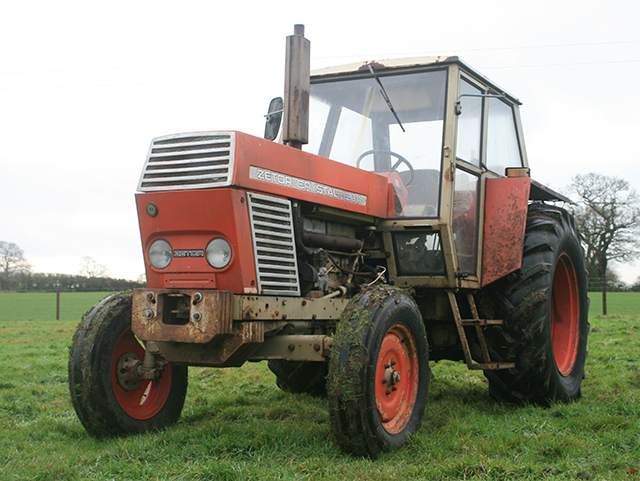
(Pic: Howard Sherren)
The British love affair with the Zetor Crystal began in 1969, with the introduction of the four-cylinder 8011, but it ramped up in 1974 when the 12011 came to the market. With the build quality of its smaller sibling, the six-cylinder tractor proved to be excellent and was everything that farmers were looking for in a larger machine.
The direct-injection Z8601 engine produced plenty of torque and was well liked, putting the power down well through the constant-mesh gearbox. The Torque Multiplier transmission provided a hydraulically-actuated ‘split’ which, unlike some rival systems, gave engine braking in both ranges and the ability to tow-start the tractor should the need arise.
The rubber-mounted cab was huge, with a flat floor, good visibility, a sprung, adjustable seat and a passenger seat, as well as a heater and wipers. Not the best looker, perhaps, but definitely quiet and comfortable.
The 12011 was appreciated by cash-conscious farmers that could see past the fact that it wasn’t built in Britain and enviable performance meant that many more Czechoslovakian tractors found their way to these shores.
At a glance
- High standard specification at a competitive price
- Large, flat-floor, ISO-mounted cab
- Change-on-the move ‘splitter’ transmission
Built: 1974-84
Engine: Zetor, 6,842cc
Cylinders: 6
Power: 120hp
Transmission: 16 fwd, 8 rev
Weight: 4,100kg
Tyres: 9.00-16, 18.4/15-34
Note: Standard spec.
Massey Ferguson 565
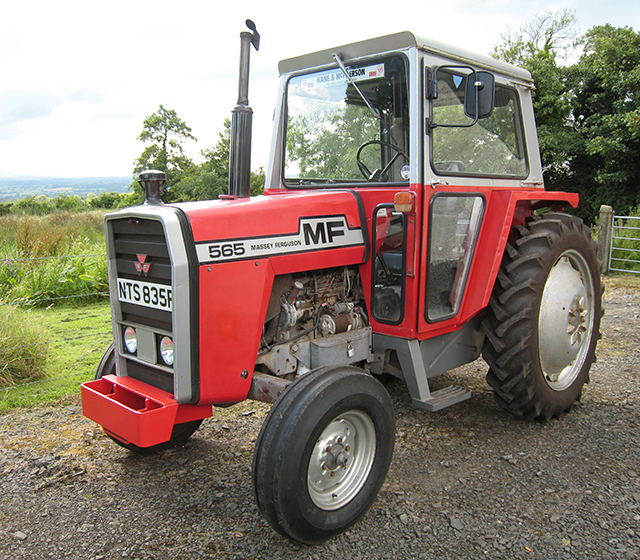
(Pic: Martin McAtamney)
The latter half of the 1970s was a busy period for Massey Ferguson, with models from the 100 Series and 500 Series available to prospective purchasers, giving plenty of choice. With all of this choice begs the question: why a 565?
As the ‘replacement’ for the 165, it’s an obvious contender, but the fact that the Perkins A4.236 is, in our opinion, one of the best tractor engines ever produced does have a lot to do with it. Maximum torque of 231Nm at just 1,200rpm meant the 565 was a good lugger, despite its modest power output and, as you would expect, it was a good starter too.
Multi-Power was an option if you didn’t fancy the eight-speed ’box and you could up-spec the basic model to suit your needs in most areas, giving you a very competent tractor in a compact form.
The 565 was perhaps best when it was fitted with a two-door cab and although it was never offered with four-wheel drive, like the 575, 590 and 595, it really didn’t matter.
At a glance
- Best-seller of the British-built 500 Series tractors
- Enviable A4.236 engine with maximum torque at low revs
- Optional equipment to transform the basic specification
Built: 1976-82
Engine: MF, 3,867cc
Cylinders: 4
Power: 63hp
Transmission: 8 fwd, 2 rev
Weight: 2,770kg
Tyres: 6.00-19, 12.1/11-36
Note: Standard spec.
International 955
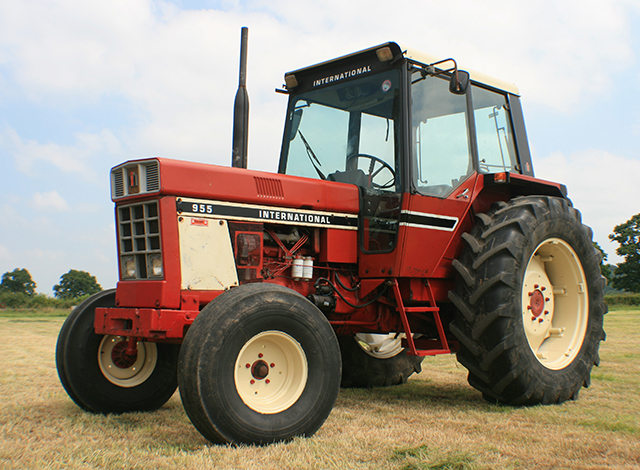
(Pic Howard Sherren)
As one of the best two-wheel drive, six-cylinder tractors of its generation, the IH 955 was always in with a chance of making our Top 10. Available in both two- and four-wheel drive configuration, most 955s were sold without a driven front axle – proving popular for forage harvesting and the like, but both variants were well liked.
Early examples (until July 1979) used the D-310 engine and although this was a good motor, the 955 became even better with the addition of the de-rated IH D-358 (5,867cc) unit that produced the same amount of power, but more torque at lower revs.
Fitted with either a Fritzmeier or Timmerman cab, depending on the factory it was built in and the market it was destined for, the 955 was one of the models that set IH on the road to six-cylinder success.
The gear lever arrangement was alien to those that had not driven one before, but synchromesh on the gears (not the range), made for a decent driving experience – aided by the 955’s sheer lugging power.
At a glance
- Great, lugging engine with beautiful exhaust note
- Comfortable Fritzmeier and Timmerman cabs
- Speed Reducer and Super Creep transmission options
Built: 1977-82
Engine: IH, 5,073cc/5,867cc
Cylinders: 6
Power: 90hp
Transmission: 8 fwd, 4 rev
Weight: 4,015kg
Tyres: 7.50-18, 18.4/15-34
Note: Standard spec.
Leyland 472 Synchro
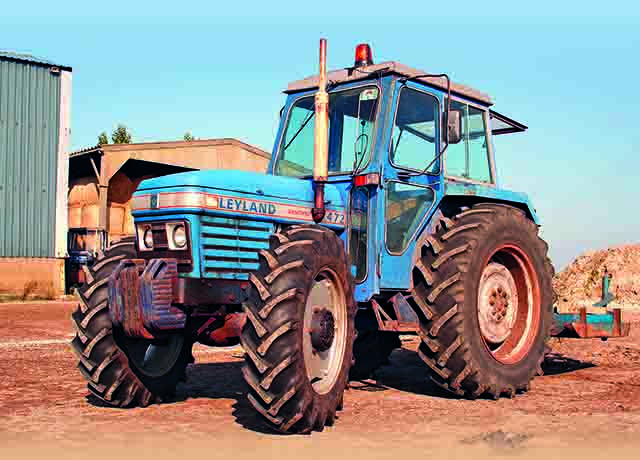
(Pic: Jonathan Whitlam)
Leyland may have been down the pecking order in terms of sales for the bulk of the 1970s, but the introduction of the Synchro range in 1978 gave the company the tractors it required to stand a chance of taking the fight to the opposition.
The new, nine forward/three reverse transmission transformed the Nuffield-derived tractors into what they perhaps should have been from the beginning. With the range lever on the left and gears on the right, plus the ability to ‘shuttle’ between first and reverse, Synchro breathed new life into Leyland.
The 472 was the four-wheel drive sibling of the 272 and it makes the Top 10 because it had a blend of sub-assembles that came together to form a formidable package. Driving the transmission was the 4/98NT engine, producing 257.7Nm of torque at just 1,200rpm, and the proven, two-lever hydraulic system, ensured that all was well at the rear.
The feather in the cap was a drop box arrangement under the gearbox, with dog clutch engagement, driving an Italian-built Carraro axle through a central propshaft.
At a glance
- Reliable Leyland 4/98NT performed beyond expectations
- Synchro transmission with useful shuttle feature
- Centre-drive Carraro front axle for additional pull
Built: 1977-82
Engine: Leyland, 3,769cc
Cylinders: 4
Power: 72hp
Transmission: 9 fwd, 3 rev
Weight: 3,360kg
Tyres: 10-28, 12-36
Note: Standard spec.
To subscribe to Tractor & Machinery magazine, click here



